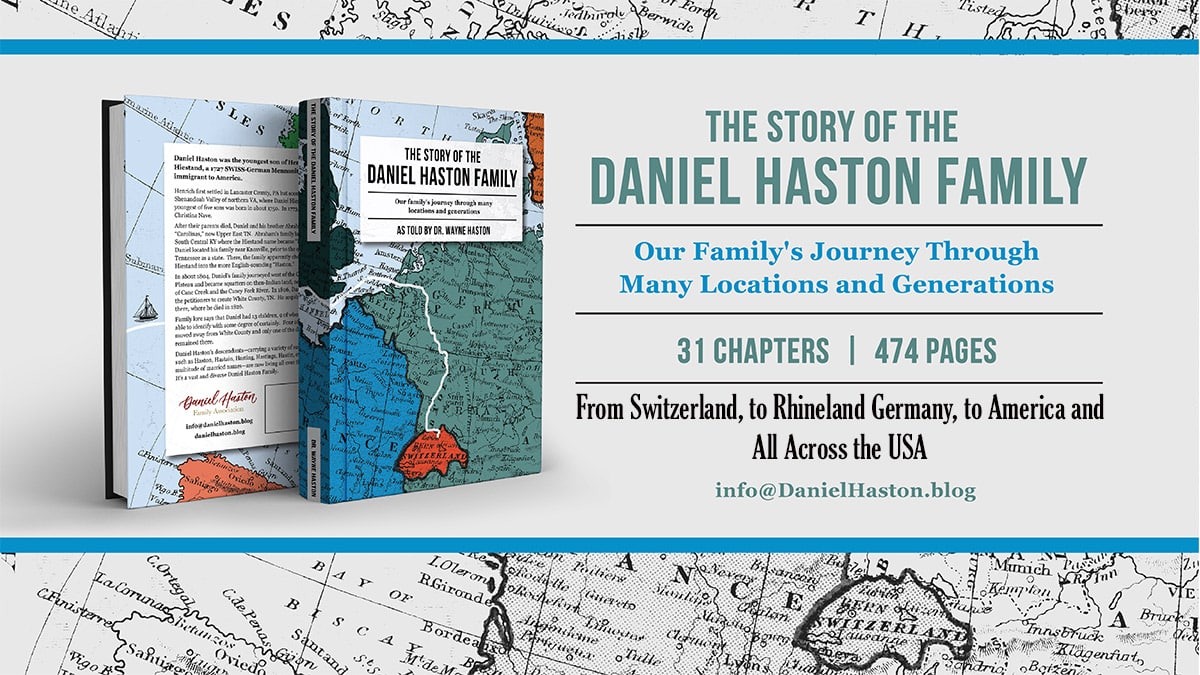Swiss Anabaptist Hiestands to the Rhineland and Beyond
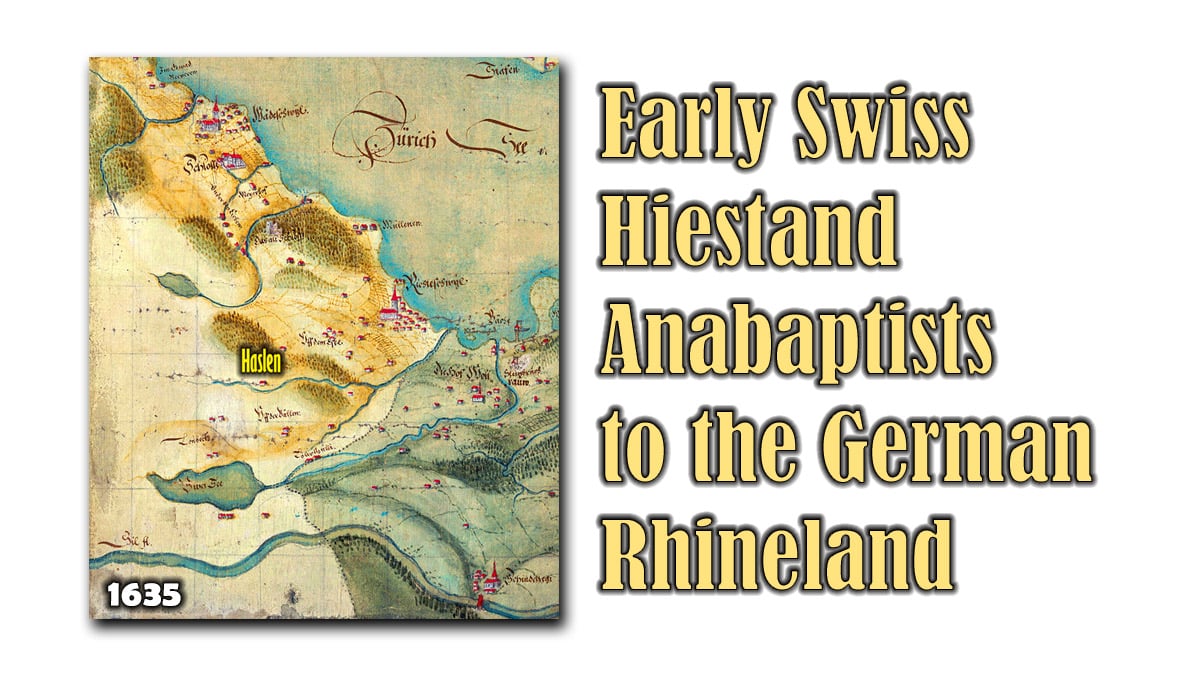
Co-authors: Dr. Peter Ziegler (Zürich, Switzerland) and Dr. Wayne Haston (Pennsylvania, USA)
(Including significant research data from Kent Douglas Hiestand)
"Early Swiss Hiestands" Series
German Language Version of this Article
From my Pennsylvania, USA point of view, when I first began learning about Hiestands in the Swiss Anabaptist movement I just assumed that most, if not all, Swiss Hiestands were Anabaptists. That assumption was based on the fact that all of the Hiestand families in the United States that I knew of were Mennonites, currently or originally when they came to America. But I soon learned that my assumptions were wrong–very wrong!
I was surprised, and a bit disappointed, to learn that nearly a hundred years of Anabaptism passed in Switzerland before there was any documented evidence of a Hiestand who was “guilty” of being an Anabaptist. And then I learned that only a very small number of Swiss Hiestands became Anabaptists and persevered in that faith journey. Many remained in the Swiss Reformed Church and others were Catholics. I’m sure if we could add to that number the 16th–18th centuries Swiss Hiestands who were sympathetic toward, and somewhat supportive of, their Anabaptist relatives and neighbors, the number increases significantly. Then there were probably many Swiss Hiestands who were baptized (or “re-baptized”) into the movement who later recanted because of social pressures and political or ecclesiastical persecutions.
Many of the Swiss Anabaptists (I’ll refer to them now as “Mennonites”) that were forced out of their homeland settled in or near the village of Ibersheim, west of the Rhine River near the city of Worms. And many of the Mennonites who later journeyed to, and took root in, America (especially Lancaster County, PA) were from those Swiss emigrant Rhineland families.
Two Questions about Swiss Hiestand Anabaptist/Mennonite Emigrations
The realities presented in the three previous paragraphs, prompt two questions about Anabaptist Hiestands:
- From which of the Hiestand families of Switzerland did the Hiestand Mennonites who settled on the German Rhineland come, particularly the Hiestands who settled in or near the village of Ibersheim.
- From which of the Ibersheim area Hiestand families did the Hiestand Mennonites who settled in Pennsylvania come, particularly those of Lancaster County, PA?
Fortunately, Kent D. Hiestand’s amazing breadth and depth of research on the Hiestand Family provide thoroughly researched and documented answers to these questions. Much of what follows is based on Kent’s years of arduous research in Switzerland, Germany, and in many places around the United States.
The Richterswilerberg Hamlet of Haßlen (now Haslen)
Henrich Hiestand's (1704-1779) grandfather and the forefather of ALL the Colonial Hiestand immigrants were born on the farm at Haslen in Richterswil.
Kent Douglas Hiestand
Haβlen (now Haslen) and Feldmoos/Veldmoos (now Fälmis) are two hamlets established centuries ago along the pilgrim road that ran from the city of Zürich to Einsiedeln in Canton Schwyz, the location of the Benedictine Abbey that was established in the 10th century. The two hamlets were only about half of a kilometer (one-third of a mile) apart. Kent Douglas Hiestand theorized that the 1401/1402 Heini Hiestand, the first known person with the Hiestand surname, was living in or near Fälmis. We do know that there was a Hiestand family living on a farm in Fälmis as early as 1439.
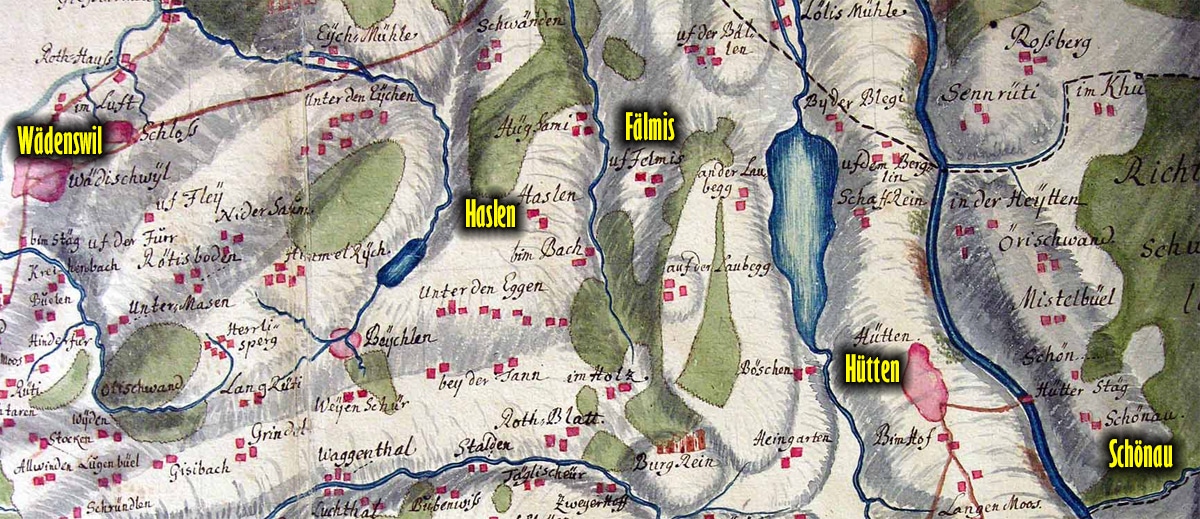
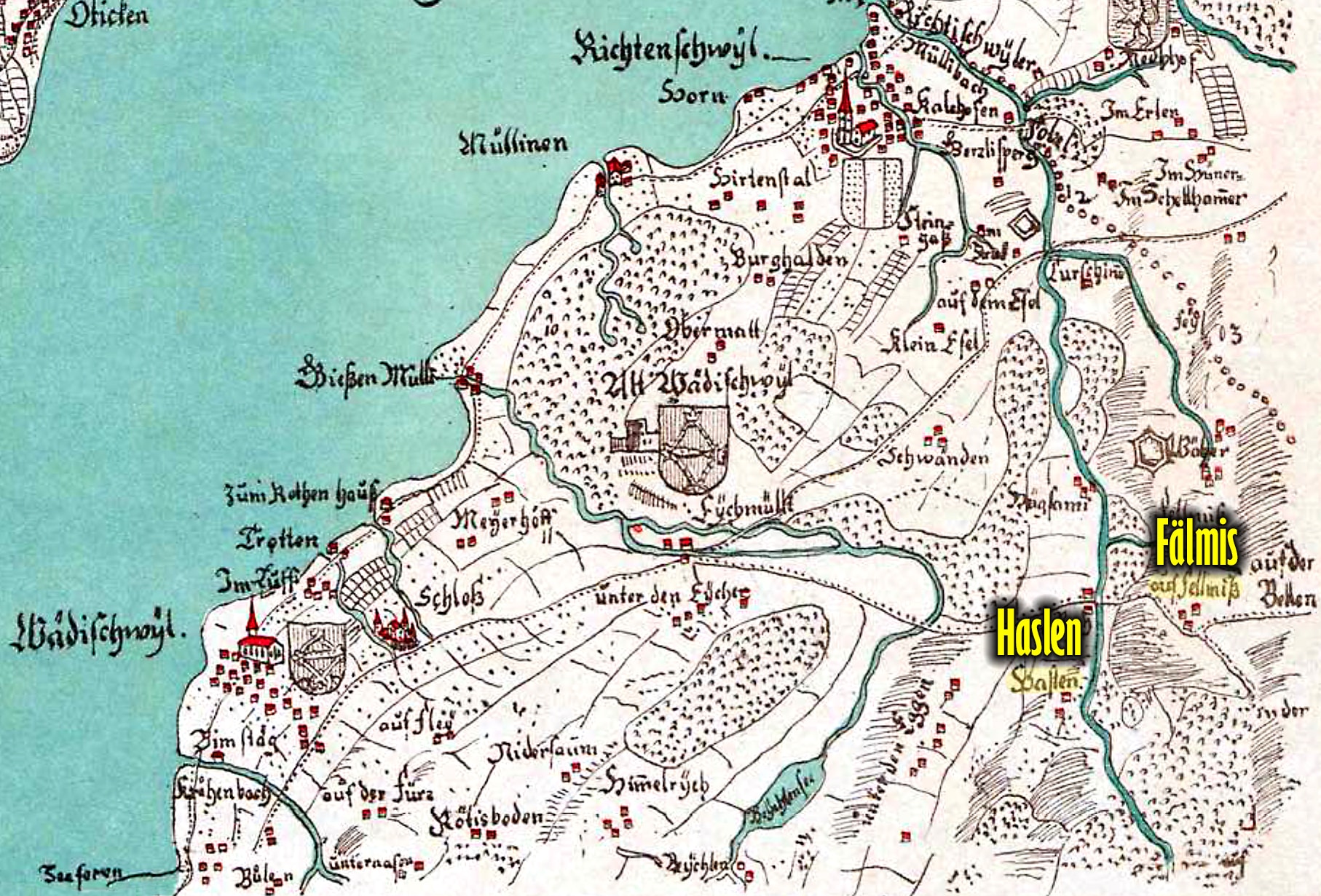
Swiss Hiestands to the Lower Palatinate on the German Rhineland
We know for sure who the Anabaptist Hiestands are, who left Richterswil Switzerland and settled am Rheim [on the Rhine River] in Rheinhessen [region south and west of the Rhine] no later than 1662.
Kent Douglas Hiestand - The Grand Chronicle of the Hiestand Family
Anna Lüthold – the Anabaptist Grandmother
It is amazing how much spiritual influence a grandparent (a grandmother, in this case) can have over her grandchildren and their descendants. Anna Lüthold, who married Heini Hiestand, became an Anabaptist matriarch in the Hiestand family. Her influence is still permeating branches of many Hiestand and Hiestand-connected families to this day.
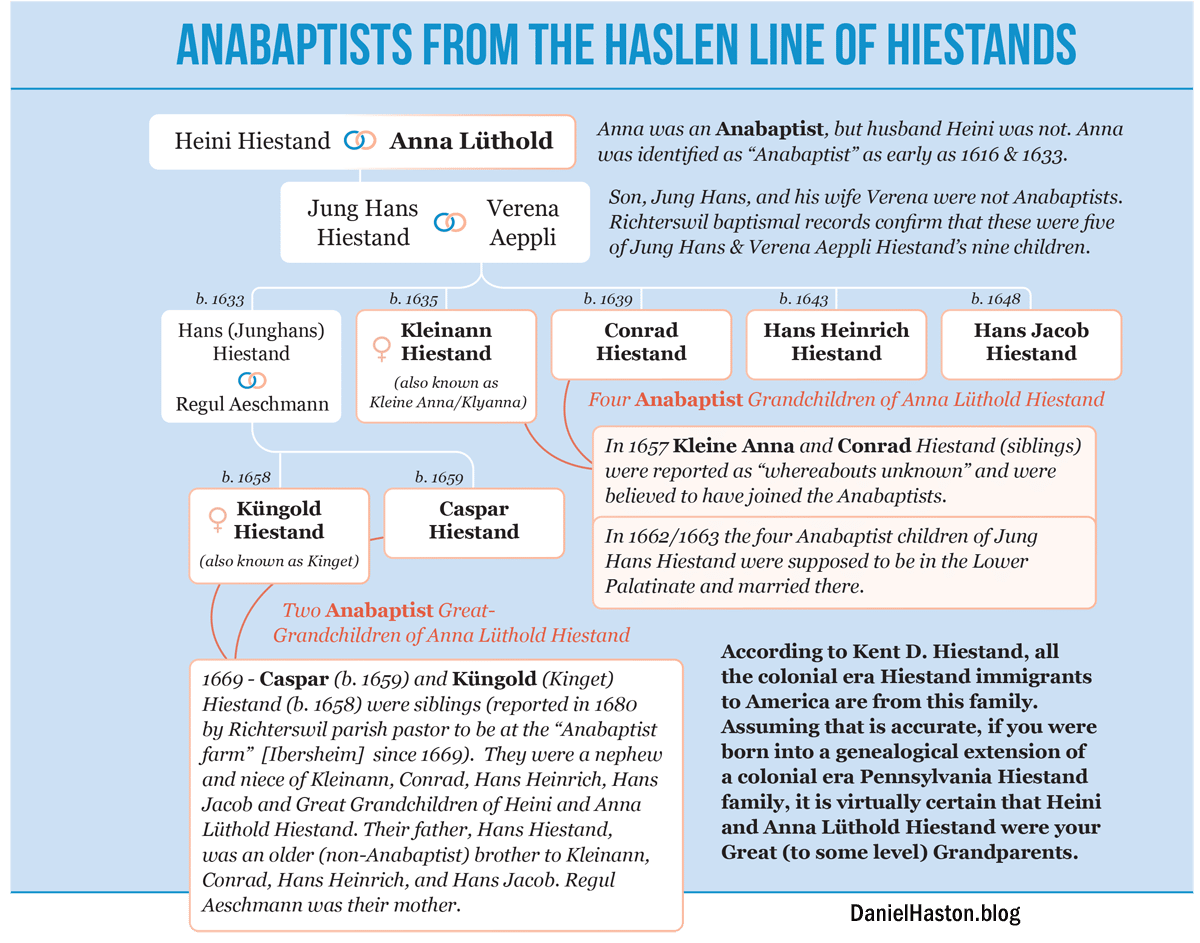
Specifically, Which of Anna Lüthold Hiestand's Mennonite Descendants Went to Colonial America?
The fathers of the American Hiestand immigrants of the colonial period are inconclusive and it is pure speculation to assume they can be connected. (paraphrased quote)
Kent D. Hiestand
I agree that, at the time of this writing, it is impossible to connect any colonial American Hiestand immigrant definitively to his parents in Ibersheim or any other location on the German Rhineland. However, I disagree with Kent that it is “pure speculation” to attempt to do so, at least for the Henrich Hiestand (born 1704) who settled in the Hempfield Township in about 1730.
Two Ibersheim Mennonite Couples Who (Theoretically) Could Have Been Parents of 1700s Hiestand Immigrants from the Rhineland
- Heinrich Hiestand married Barbara Mollinger, 25 November, 1694
- Hans Heinrich Hiestand married Maria Gochnauer 6 February, 1695.
There is enough evidence to “suggest” that Maria Gochnauer was probably the mother of early 1730’s Henrich Hiestand.
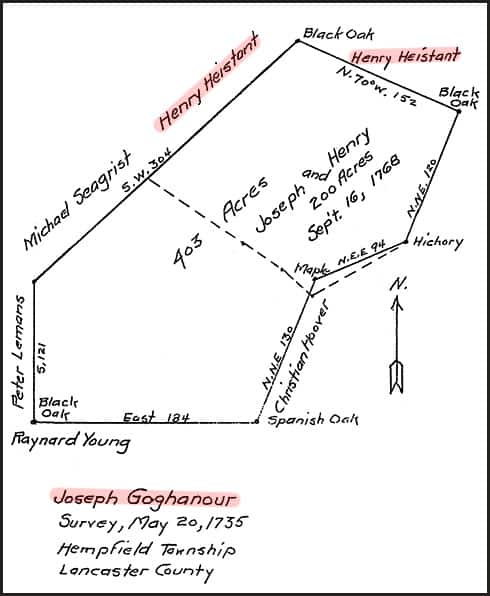
Both Henry Heistant (Hiestand) and Joseph Gochanour (Gochnauer/Gochenaur) arrived in America prior to October 1727 when passenger lists were required by law in Pennsylvania. They possible/probably arrived on the same ship, although we don’t know the name of the ship or the date of its arrival. Their names appear close to each other on the 1728 naturalization document.
Henry and Joseph had adjacent tracts of land in Hempfield surveyed on the same day, May 20, 1735. Those were the only two surveys in Hempfield Township created on that day.
Henry Hiestand later settled in the Northern Neck of Virginia, as did Jacob Gochanour, supposedly the brother of Joseph Gochanour. When Jacob Gochanour’s will was created on November 30, 1771, Henry’s son, Peter Hiestand, was made a co-executor of Jacob’s estate (with Jacob’s wife). Even though the Hiestands lived in the same general area, they were not conveniently close neighbors. And Jacob Gochanour had sons who could have been chosen as co-executors.
I theorize that Heinrich Hiestand who married Maria Gochnauer on February 6, 1695 Friedrichstadt, Germany were the parents of Henrich Hiestand who arrived at Philadelphia, Pennsylvania in 1727 and later moved to the Shenandoah Valley of Virginia. And based on that theory, I believe Henrich Hiestand was a first cousin of Joseph and Jacob Gochanour. -Wayne Haston
The Future of Genetic (DNA) Genealogy
The advancements in the use of DNA testing in historical family research over the past two decades are mind-boggling. Innumerable genealogical “brick walls” have been penetrated! But as the song says, “Baby, you ain’t seen nothin’ yet.” In the decades ahead, future developments in genetic genealogy will unveil even more and greater mysteries in our families’ histories. I won’t even begin to speculate what kinds of hidden secrets and long-lost human connections will be exposed. For family researchers, time and DNA research are on our side and the side of the family historians who will follow us.
I think I can say with confidence that future generations of Hiestand family researchers will be able to learn much more about our family’s history than we ever thought possible. Many of our tentative assumptions will be confirmed or rebutted. And some of the haunting mysteries that “brick wall” us now will crumble under the power of genealogical genetics. -Wayne Haston
Haslen - Fälmis - Samstagern in the Modern Era
Today (2022), Haslen and Fälmis, each with approximately 50 residents, are now small subdivisions on the edges of Samstagern. In 1877 a train station was established at Samstagern on the Wadenswil – Einsiedeln line, which led to its growth. The population in Samstagern now is approximately 3,000 and is rapidly increasing.
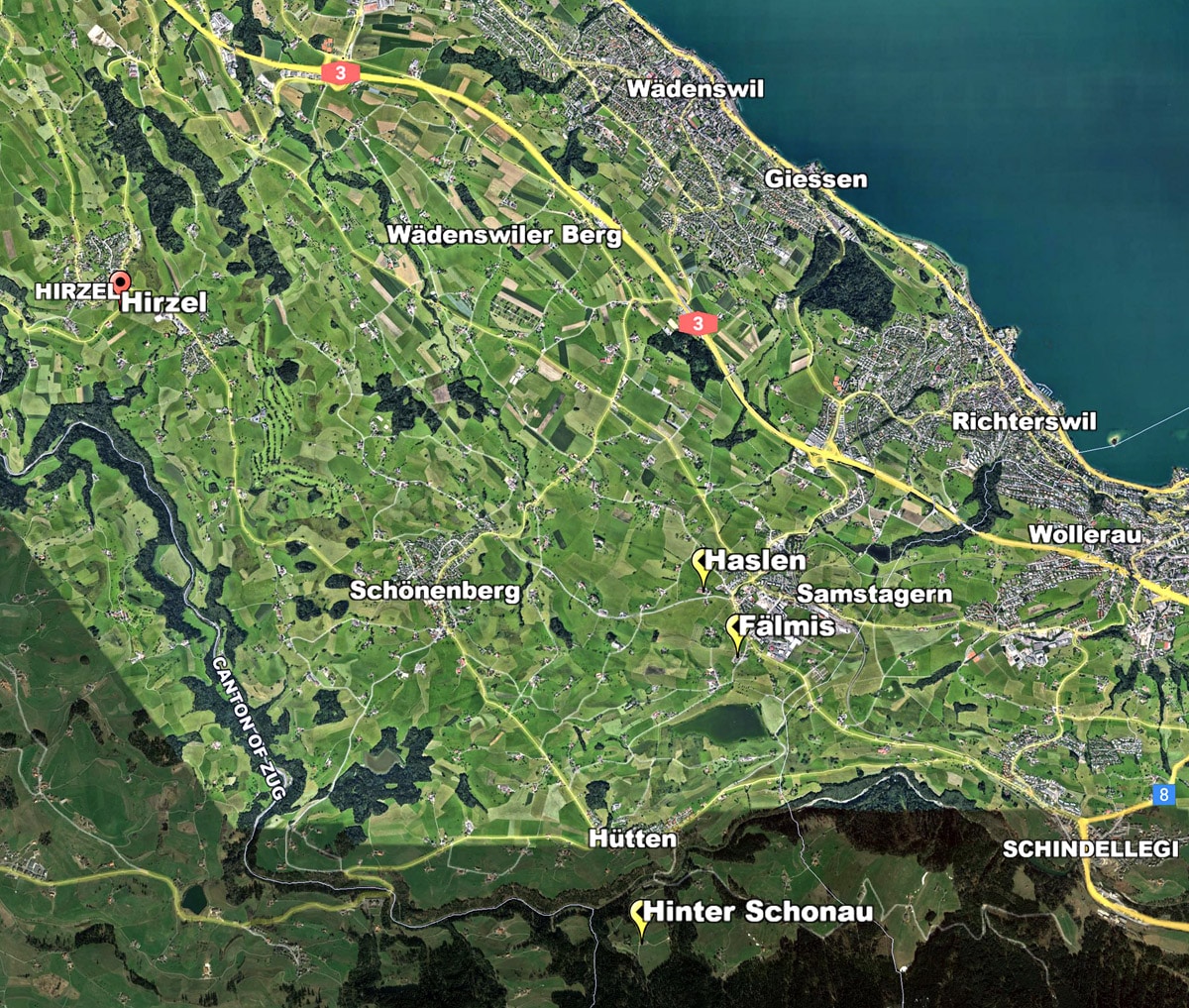
If you appreciated this article, please share it with others who might also enjoy it.
